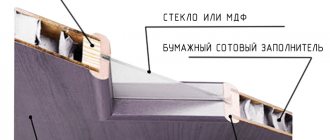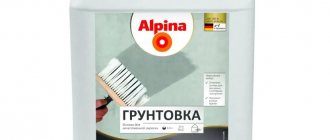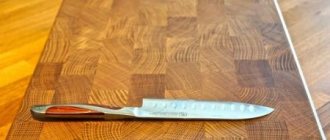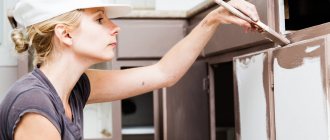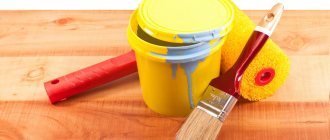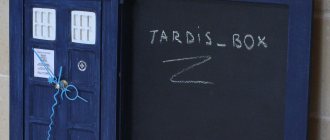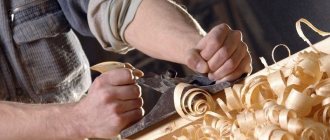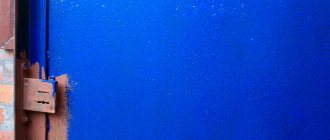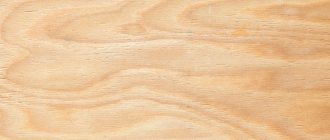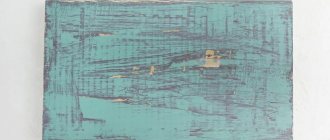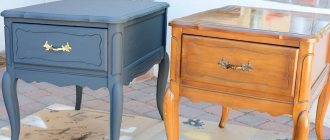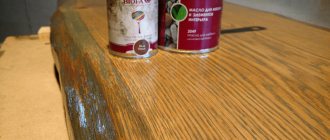The main enemies of a wooden floor are moisture and various kinds of bacteria and microorganisms. Under the influence of these factors, the construction material begins to rot, loses its original aesthetic properties and serves much less than it should.
How to cover a wooden floor
To prevent the occurrence of these problems, the wooden floor must be coated with a special protective compound. The modern market offers a large selection of products that not only help to increase the durability and other important performance indicators of wood, but also make its appearance more noble and attractive.
After reading the information below, you will get a complete understanding of the features of the selection and use of existing compositions, which will allow you to independently cope with this event.
Available types of wood treatment compounds
Reliable and effective protection of wooden structures from harmful external influences can be ensured using the following compounds:
- wood varnish;
Polyurethane varnish Pallmann IS 90 Sport for wooden floors
- wax products;
- oil based coatings.
Each option mentioned will give the wooden floor an attractive appearance, while at the same time ensuring increased resistance of the material to various types of influences and loads and helping to extend its service life.
Hard wax oil for wooden floors Saicos
Next, you are invited to familiarize yourself with a description of the basic properties of varnish, wax and oil, as well as study the technology for applying each of these materials. But first you should definitely understand the procedure for preparing the surface for subsequent processing.
Oil-wax
Purpose
Any wooden structures gradually become unusable due to increased air humidity and constant extreme temperatures.
The main task of antiseptics is to protect against the destructive effects of moisture, the proliferation of pathogens, fungus, and mold. Bath treatment products can be purchased in the form of an ointment or solution.
Antiseptic agents reduce the ignition threshold of wood. They are recommended to be applied around the stove to protect surrounding surfaces.
An antiseptic is a chemical that can harm the body. Therefore, before use, it is necessary to study its composition.
Instructions for preparing a wooden floor for coating
The procedure depends on whether you are working with a new floor or a previously used structure.
Guide for a new floor
First of all, check the condition of the fasteners that secure the deck boards. The heads of screws and nails need to be “sunk” into the material by about 2-3 mm. Next, the remaining recesses are covered with a sealing agent. Instead, you can use a special putty designed for wood processing. It is important that the color of the material matches the color of the boards as much as possible.
Drive in the nail heads and apply putty.
Cover the deck with starter varnish and let it dry. The drying time is determined by the moisture content of the boards. If the material humidity is more than 12%, the varnish will dry for a very long time - up to several months. If the boards have been well dried, the waiting period will be reduced to 2-3 weeks.
Apply varnish to the floor
Guide for old floor
If the existing deck boards are in good condition and do not require replacement, preparation begins by removing the existing paint or other coating. If you find defective boards, be sure to replace them before starting work.
Old paint should be removed
The paint can be easily removed using a sanding machine. But it is not advisable to buy this unit for single use. If your place of residence does not provide such tools for rent, use the old and proven manual method.
Prepare the following:
- iron (preferably one that you don’t mind);
- paper. Take it with a reserve, it will take a lot;
- special paint remover;
- electric plane;
- grinder with an attachment for sanding wooden surfaces;
- several spatulas;
- sandpaper. Practice shows that it is most convenient to work with material having a grain size of 150-180.
Proceed to remove the old paintwork. Place paper on the base and place a well-heated iron on top of it. As a result of this treatment, the paint will come off the floor and stick to the sheet. Remove the remaining areas of the coating with a spatula and knife. If paint has become embedded in the floor material, apply a stripper according to the manufacturer's instructions.
Video - Removing old paint from the floor
Remove the thin top layer of material from the cleaned boards. An electric plane will help you with this. Make sure that the fastener heads do not protrude above the boards.
Electric planer
Important! The work is quite dusty, so for your own safety, wear a respirator and safety glasses.
Sand the surface using a grinder with the previously mentioned attachment and sandpaper. Collect the dust, but do not throw it away - it may be useful to you in the future.
Sanding a wooden floor
Fill cracks and other flooring defects. If you do not have a special primer of a suitable color, use a mixture of PVA glue and wood dust. Add dust until the desired color is obtained. If you use the second option, be careful and attentive: any excess glue that appears must be immediately removed from the surface. This is easily done with a damp cloth.
For putty, mix sawdust and PVA glue
Finally, all you have to do is apply a starter varnish to the floor and let it dry. The recommendations are similar to the previous case.
Important points
Some of the volatile components in the composition of impregnations can cause real harm to health, so they cannot be used in a steam room.
If necessary, you can carry out disinfection in a bathhouse with your own hands. However, many experts do not recommend using synthetic compounds for these purposes. Why? The temperature in the sink and steam room is often very high. It provokes the evaporation of antiseptic components from the surface of the floor or wall that has been treated with it. Some of the volatile components can cause real harm to health.
To prevent the negative effects of anti-putrefactive agents on the body, the choice of protective compounds must be approached with care:
- In the rest room and dressing room, the air temperature, as a rule, does not exceed 27 degrees. They can be used without problems with synthetic compounds;
- In the sink and steam room both humidity and temperature are high. To eliminate the possibility of volatile substances entering the body, it is better to treat logs, floor boards and other wooden elements with organic-based compounds.
Varnishing the floor
Varnishing the floor
Types of material
There is a fairly wide range of varnishes on the market. Before you start, be sure to familiarize yourself with the features of the most popular representatives of this category.
Table. Properties of different wood varnishes
| Type of varnish | Characteristics |
| Water soluble | Advantages: dries quickly; adheres well to the base; doesn't stink. One- and two-component modifications are available for sale. The first ones usually last no more than 2-3 years - after this time the floor will have to be sanded and treated again. If you apply a two-component varnish in 3 layers, it will last about 10 years even in rather harsh operating conditions. But such material also costs much more. |
| Alkyd | The advantage is that the structure of the treated wood becomes more pronounced and beautiful. Disadvantage: long drying time. The varnish is excellent for covering the so-called. "floating" floor. To prevent the varnish from wrinkling, experts recommend limiting its consumption to a maximum of 120 g/m2. It is important that during the drying process the varnish is not exposed to heat from radiators and other heating devices. Contact with direct sunlight is also prohibited. |
| Anhydrous polyurethane | The main advantage is excellent wear resistance. Also, such varnishes tolerate contact with water and various chemical detergents well. Important! The moisture content of wood coated with such a product should be no more than 10%. Otherwise the coating will bubble. |
| Acid curing | Characterized by the greatest strength. Resistant to a wide variety of influences. Natural light shades are created on the floor material. You just need to follow the basic recommendations for using the product, namely: the varnish is mixed with the hardener strictly before using the mixture; the performer must wear personal protective equipment - a respirator; There must be a constant flow of air in the room. Violation of these recommendations may result in irritation of the mucous membranes for the performer. |
Features of water-soluble paints and varnishes
Wear resistance is an important property that distinguishes polyurethane varnish from other water-based compounds. It is worth noting that the first water-soluble paints and varnishes formed an insufficiently strong film on a wooden surface. Therefore, to maintain an aesthetic appearance, it was necessary to frequently renew the varnished panels. In this regard, the first water-based compositions could hardly be called economical.
Disadvantages of water-based varnishes without the addition of polyurethane:
- reduced resistance to chemical and mechanical influences (does not apply to polyurethane compounds, which have high wear resistance);
- some versions of water-soluble varnishes require application to a wooden surface only after preliminary priming;
- with reduced humidity, sagging may appear;
- the need to select care products;
- the likelihood of getting into the seams between the layers of parquet, which causes the boards to stick together;
- not too long service life of the coating.
The only drawback that remains with water-based polyurethane coating is its not the best resistance to aggressive chemical components. Concentrated alcohol-based compounds have a particularly bad effect on the surface. Therefore, strong alcohol spilled on the parquet can leave an unsightly stain on the varnish that will be difficult to remove. Therefore, when using floors coated with water-soluble varnish, you should be especially careful.
Water-based polyurethane varnish forms a protective film on the surface of the flooring that does not change the natural beauty of the wood or spoil its pattern
In addition, an important feature of such varnishes is that they do not have a negative effect on the surface of the wood. Therefore, when applying this paint and varnish material, yellowish spots do not appear on the wooden surface. All this makes water-soluble polyurethane varnish more popular than conventional solvent-based compounds.
All this makes water-soluble polyurethane varnish more popular than conventional solvent-based compounds.
Unlike conventional varnishes, which have a strong odor, water-based polyurethane compositions practically do not irritate the olfactory organs. Accordingly, when working with them there will be no headaches, allergies, and so on. Thanks to this, all work can be carried out at any time without evicting all family members from the premises. In addition to this advantage, water-soluble varnishes have other advantages. Here are the main positive qualities of water-based varnishes:
- No unpleasant odor.
- Possibility of carrying out work without evicting residents from the premises;
- Quick drying time, up to 2-3 hours. After just 8 hours, the floor covering will be completely ready for use, and you can walk on it freely. After a few days, you may even be able to move furniture on the painted varnish.
- Absolute fire safety.
- Easy to apply, as the water-based polyurethane varnish has a self-leveling formula, which ensures an even layer of coating.
- Possibility of applying several layers per day due to quick drying.
- Good adhesion of the composition, so it does not peel off over time due to excellent adhesion to parquet.
- Environmentally friendly, which makes the varnish absolutely safe for people and animals.
- Wear resistance of varnish.
Procedure for applying varnish
Various tools are used to apply varnish. So, for example, quick-drying water-soluble compounds are applied with rollers of the highest quality. The performer must distribute the material over the surface using exclusively translational movements. First, the product is applied across the flooring, after which it is leveled in the longitudinal direction, i.e. the surface is varnished “crosswise”.
Procedure for applying varnish
You can use a spatula to apply the first layer of material. The performer makes fairly quick S-shaped movements, evenly distributing the composition over the base. This technology allows for higher coating strength.
If using a brush, the material should be applied in neat U-shaped strokes. In this case, the new stroke should slightly overlap the previous one.
It is most convenient to start work from the wall opposite to the exit from the room - this way you will not have to walk on the applied composition.
Wood: pros and cons
What types of coatings exist and what qualities do they add to wood? Let's determine the natural advantages and disadvantages of natural materials.
When installing a wooden floor in a room, the owner must understand what qualities the floor will have and what it will have to deal with.
The advantages of this material include excellent thermal insulation properties, sufficient strength, ease of repair and environmental friendliness.
The disadvantages include:
- low level of sound insulation;
- high moisture absorption;
- instability to abrasion and mechanical stress (depending on the type of wood);
- changes in physical properties under the influence of temperatures and humidity levels;
- easy flammability;
- susceptibility to rotting;
- not resistant to insects and microorganisms.
How to coat a wooden floor with oil
How to coat a wooden floor with oil
The oil penetrates the wood structure, protecting the material from the inside and without creating a continuous film on top of it. As a result, the wear resistance of the wooden floor increases significantly. An additional advantage of the oil is its environmental friendliness. As a rule, such coatings do not contain solvents or are present in insignificant quantities.
Solid oil for wooden floors
It is important to know that on a floor covered with oil, material defects will be much more noticeable than if varnish is used. Therefore, the work must be carried out step by step and in strict accordance with the manufacturer’s recommendations. A general requirement that is relevant for all such compositions is the timely removal of excess oil from wood. Otherwise, the floor will be covered with unsightly dark spots.
Oil application
It is impossible to provide specific instructions for covering a wooden floor with oil, because... the procedure is largely determined by the manufacturer's recommendations. We can only describe the general sequence:
- the surface is carefully polished. Small areas can be sanded manually; large areas can be processed more conveniently and quickly using a sanding machine with an appropriate attachment;
- cracks and other defects are sealed with putty;
- the surface is covered with a thin and uniform layer of oil. For application, you can use rollers, spatulas and devices specially designed for such work. This point, as well as other recommendations for applying the product, should be further clarified in the manufacturer’s instructions.
On average, the oil hardens for 12 hours. After this, the material will need to be given another 3-4 days to gain strength.
Wood oil extends the life of the floor
Important! After the first treatment of a wooden floor with oil, the surface will become very dirty. Such marks will stop appearing only after the material is completely saturated, which on average takes several years.
If necessary, such a coating can be restored without much effort: the damaged area is simply sanded and re-impregnated with oil.
Using oil you can reliably protect the floor from moisture
Protecting joists from insect damage
Often, owners of wooden houses are faced with a big problem - insect pests that settle in wood cause them a lot of trouble. This phenomenon must definitely be combated. Since the place where the logs are located is always warm, insects prefer to settle and breed there. Entire colonies of pests can render floors unusable and require major repairs.
To prevent this, it is necessary to treat the logs using special protective agents. As practice has shown, the most effective and proven method is the use of resin. It still needs to be prepared for application before use.
The resin is heated by placing it in a metal container. After it softens, you can begin to work. Impregnation for floor joists is applied using a paint brush. After completing this procedure, no pest can penetrate the wood structure. The fact is that such a durable layer almost does not collapse over time.
Using wax to coat wood floors
Rubbing oil-wax into wood
The main advantage of wax is its absolute environmental friendliness and safety for human health. Wax can be used both as an independent coating and in combination with the previously discussed oil.
Floors covered with hard wax look as natural as possible.
The technology for applying wax is extremely simple and straightforward:
- an even layer of wax is distributed over the previously prepared surface (recommendations were given earlier);
- The material is given time to dry. This point should be clarified separately in the manufacturer's instructions, because drying time may vary depending on the properties of the specific composition;
- The surface is thoroughly polished using a clean cotton cloth.
Experts recommend renewing the wax coating twice a year. Otherwise, the frequency of such processing remains at the discretion of the owner.
Now you know what can be used to cover a wooden floor and how to handle each material considered.
Good luck!
Oil impregnations
Such substances have been used for a long time and their effectiveness is confirmed by ancient estates of the 18th-19th centuries, in which the floors are in perfect condition to this day. At that time, they did not yet know about varnish for wooden floors, but drying oil, hemp or linseed oil were actively used.
The surface of the boards was additionally rubbed with wax, which made it possible not to maintain the coating, but to protect it from stress for a period of 10-12 years. Some might say that more than a dozen years have passed between the 18th century and our time. The fact is that the applied substances function for 10-12 years, and then they are simply cleaned off, the wooden floors are sanded, and the oil and wax treatment procedure is repeated. At the same time, grinding is an extremely important stage of work. It is worth noting that even in ordinary military barracks of that time, pine floors were used for at least 50-70 years without replacement.
Advantages of using oils when processing pine boards:
- the oil is more stable when used in rooms with poor heating and large temperature changes (for example, a country house);
- the oil penetrates deep into the structure of the board, thereby creating a moisture-protective layer that prevents warping of the wood;
- after processing the board, it can even be used outdoors and under intense exposure to moisture, which has been proven in practice when creating ships from pine boards;
- Unlike the composition of some paints and varnishes for pine floors, oil impregnations do not change the structure of the wood and preserve its naturalness. Therefore, pine boards can be used even in specialized institutions (hospitals, kindergartens).
Natural and synthetic oils presented on the modern building materials market are very good at processing wood and create reliable protection against the penetration of moisture and air through the coatings, but oil is not able to create surface protection against wear, so additional treatment of the boardwalk with wax is necessary. If we are talking about the floor on the balcony, you need to know what is the best way to cover the wooden floor on the balcony.
Also, wax can be contained in the composition of the oil impregnation used, and then during processing an outer layer will be created, which will significantly increase the durability of the coating and maintain its presentability for a very long period of time. Typically, either natural wax is used, or a synthetic alternative based on polyurethane is added to the impregnation.
When working with several substances at the same time, it is best to purchase materials from one manufacturer to ensure the closest possible interaction. The prices for such products on the domestic construction market are not the highest, since the companies listed above have production facilities in Russia.
Marmoleum
Different types of marmoleum
Natural and environmentally friendly finishing materials play an important role when choosing them
When choosing a floor covering, you should pay attention to marmoleum - a material that appeared in the last century and is based on natural materials - chalk, jute, cork, wood flour.. Thanks to its natural composition, the scope of application of marmoleum extends to educational (schools, universities ), medical and health institutions, kindergartens.
Thanks to its natural composition, the scope of application of marmoleum extends to educational (schools, universities), medical and health institutions, and kindergartens.
The main advantages of marmoleum:
long service life - up to 20 years; composition of marmoleum - natural ingredients; resistance to chemical components (acids, salts, all kinds of reagents); fire resistance; antistatic; bactericidal properties (especially important for families with children); resistance to physical impact. A square meter of marmoleum can withstand up to 160 kg of load without consequences; UV resistance; the material is also not afraid of high humidity: when interacting with moisture, its properties do not change; economical due to self-sufficiency: this flooring does not require additional hydro, noise and thermal insulation; the price per square meter of the product is on the same level as laminate; simplicity of laying the material, allowing you to carry out the process yourself, without the help of professionals.
The disadvantages of marmoleum include its fragility; therefore, when choosing marmoleum, you should carefully check each element for cracks or other deformations. Transportation and transfer of the material should be carried out with the utmost care, avoiding deformation of the edges of the product. The material cuts quite poorly.
The disadvantages of marmoleum include its fragility; therefore, when choosing marmoleum, you should carefully check each element for cracks or other deformations
Transport and transfer of material should be carried out with the utmost care, avoiding deformation of the edges of the product. The material cuts quite poorly.
90% of marmoleum produced is in rolls. The standard width reaches 2 m, the thickness limits are 2-2.5 mm. For objects with increased load, the thickness of the product is 3.2 and 4 mm.
What to prefer?
There are two staining methods. 1
Surface painting is used in cases where maintaining the aesthetics and appearance of the wood is extremely important. This type of protection and decoration is used everywhere, at the final stage of floor finishing in timber houses, bathhouses and other wooden buildings.
2. Deep coloring is possible only in industrial conditions, because to implement it, special baths and autoclaves are needed, in which a solution under high pressure is injected into wood capillaries, filling the entire free volume.
Oil impregnation
Oil for treating wooden floors is made from natural substances (linseed, sunflower, soybean oil) or artificial components, with the addition of, for example, polyurethane. The oil penetrates deeply into the thickness of the coating, leaving only a thin layer on the surface. As a result of the procedure, the floor becomes strong and acquires a silky shine.
The oil gives the floor a silky shine
Oil solutions come in different viscosities:
- thick (contain 90% natural oil);
- medium viscosity (dry residue is 40-50%);
- liquid (dry residue 20-40%).
Professionals strongly advise applying oil in high-traffic areas (living room and hallway). They can be used without fear in unheated rooms, in open areas, on beams in constant contact with water (bathtub, swimming pool). Oiled floors are easy to refresh: just add a special product to the water when washing. Before application, the floor must be sanded, cleaned and dried.
Varnish coating
The use of varnish creates the effect of volume and contrast of the wood pattern. The varnished floor shines and perfectly decorates the room. The varnish composition protects against moisture and mechanical damage.
Varnish adds volume to wood flooring
What types of varnishes are there?
The following types of varnishes are distinguished:
- Solvent-based varnish for wooden floors saturates the wood well and changes its color. It should be applied in a thin layer in a well-ventilated area to prevent wrinkles and ensure rapid hardening. This varnish is ideal for “capricious” wood - ash, maple, beech.
- alkyd varnish is colorless, stable and durable. The only negative is that it takes quite a long time to dry.
- reactive varnish has high adhesive properties and forms an elastic film that does not affect the structure and original appearance. It will take at least 10 days to form a strong film.
- Polyurethane-based varnish is used for valuable wood species. Such compositions are durable, resistant to abrasion and chemical attacks.
According to the level of gloss, varnishes are high-gloss, glossy, semi-gloss, matte and semi-matte. The gloss level of glossy varnish is 90%, which makes the wood floor look like a mirror; matte and semi-gloss varnishes reflect a small amount of light from the surface.
Glossy varnish finish
